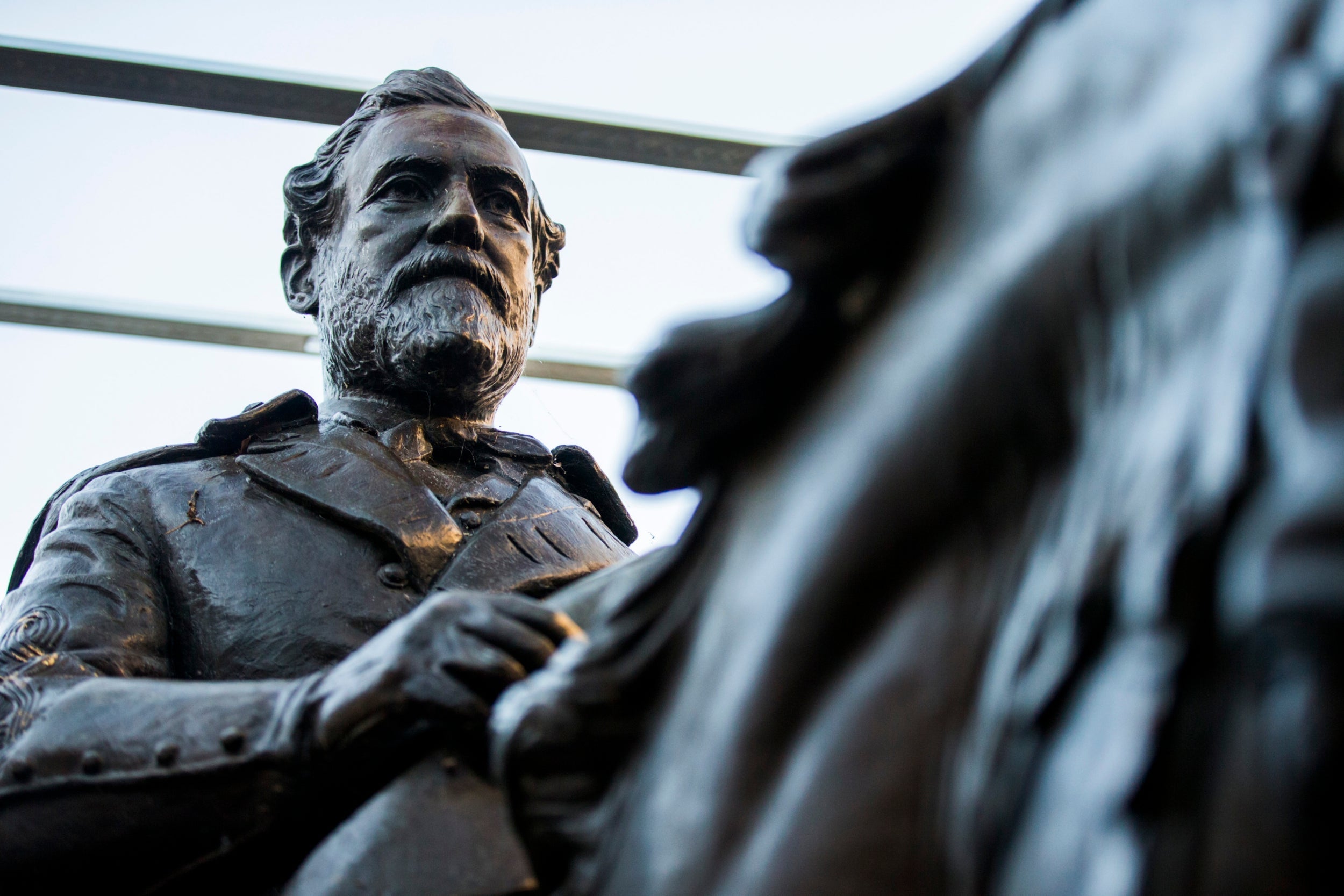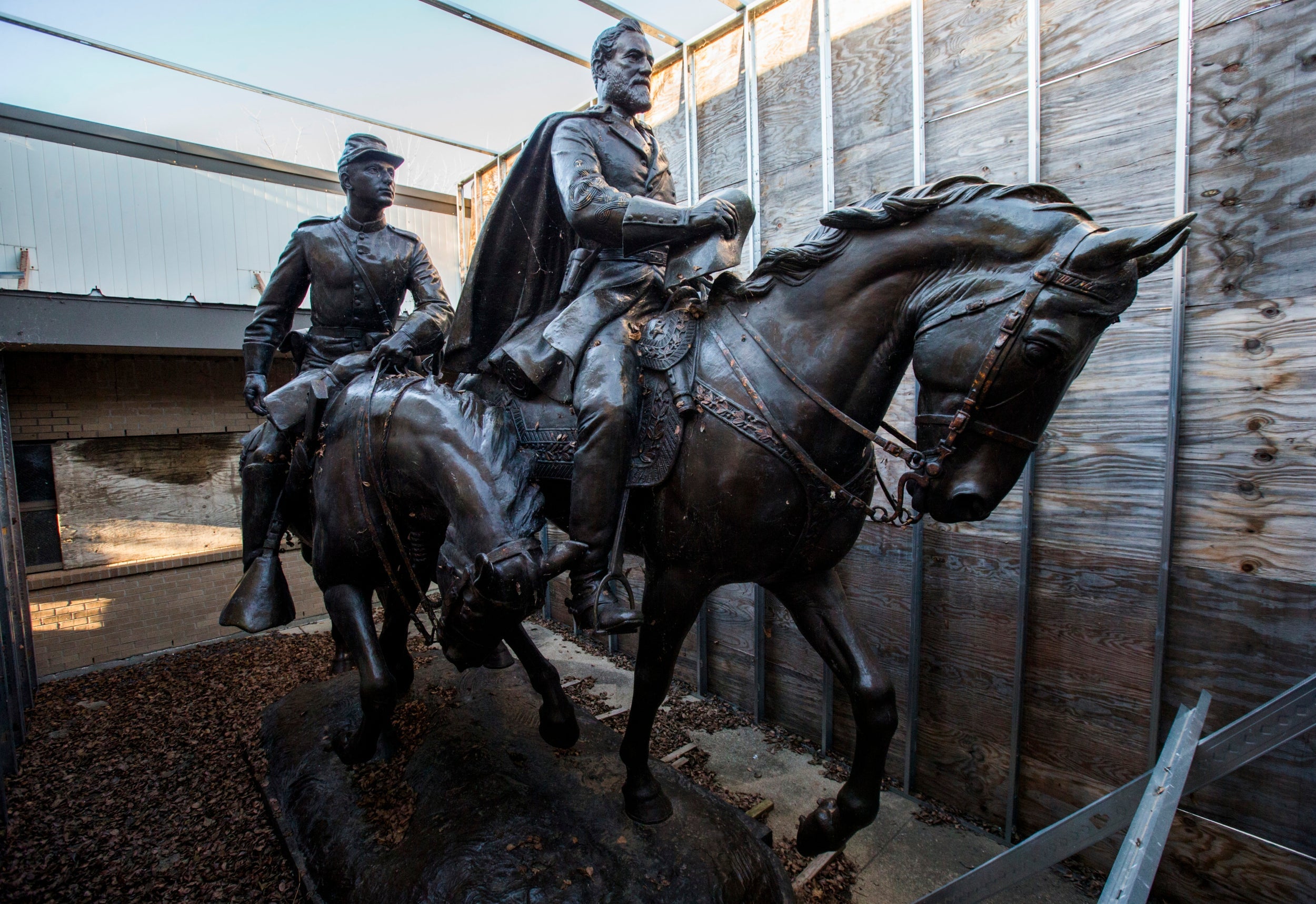Robert E Lee statue removed from Dallas park sells for more than $1.4m
Monument of Confederate leader sells on condition buyer cannot display it in public

Your support helps us to tell the story
From reproductive rights to climate change to Big Tech, The Independent is on the ground when the story is developing. Whether it's investigating the financials of Elon Musk's pro-Trump PAC or producing our latest documentary, 'The A Word', which shines a light on the American women fighting for reproductive rights, we know how important it is to parse out the facts from the messaging.
At such a critical moment in US history, we need reporters on the ground. Your donation allows us to keep sending journalists to speak to both sides of the story.
The Independent is trusted by Americans across the entire political spectrum. And unlike many other quality news outlets, we choose not to lock Americans out of our reporting and analysis with paywalls. We believe quality journalism should be available to everyone, paid for by those who can afford it.
Your support makes all the difference.It happened by city decree in the dark of night, or by civic demand at the hands of protesters. When the movement to reckon with Confederate symbols swept the nation, monuments that had long stood in city parks and on college campuses were suddenly dismantled.
There was often no clear plan for the future, and few long-term solutions have emerged.
Now, one city has settled on an unusual answer: Sell the statue to the highest bidder.
A bronze statue of Robert E Lee on horseback that had sat in a Dallas park until 2017, sold on an online auction for more than $1.4m (£1.1m).
The sale came with one crucial condition: The statue cannot be displayed publicly in the Dallas-Fort Worth metropolitan area.
The auction is among the first of its kind since the movement to remove Confederate monuments picked up speed, first in 2015, after a white supremacist killed nine black people at a church in Charleston, South Carolina, and then in 2017, when a white supremacist rally in Charlottesville, Virginia, led to the death of a counter-protester.
But while the Dallas case may offer other cities a potential way forward, it also highlights the logistical and ethical challenges of transplanting statues that are often physically enormous and remain viscerally controversial. This week, a Confederate monument in Nashville was sprayed with graffiti that read, “They were racists”.
Many Confederate statues being debated today did not originate during the Civil War era, when Southerners built obelisks in cemeteries and other tributes with themes of mourning. The towering figures of individual soldiers and monuments in public squares generally came later, historians say, during the rise of Jim Crow laws and subsequently during a backlash against desegregation.

“That is when you are simultaneously seeing the dedication of these monuments,” said Christy Coleman, the chief executive of the American Civil War Museum in Richmond, Virginia. “They are not separate things. They are a reassertion of the ideal.”
In Dallas, the Robert E Lee monument, which was unveiled in a 1936 ceremony attended by President Franklin D Roosevelt, was part of the “Lost Cause” movement.
The movement played down slavery’s role in the Civil War and romanticised the Confederacy as noble and heroic.
“It shall stand here on this busy corner of our city as a perpetual memorial to the character, valour and achievements of this matchless leader of our own Lost Cause,” the mayor of Dallas said at the time, according to a copy of the dedication program.
The city ordered the statue’s removal in 2017 amid a national wave of unrest over Confederate statues.
Initially, a task force recommended that the statue be donated to a museum or educational site, where it could be displayed in full context. But no local options proved appropriate, said Jennifer Scripps, the director of the office of cultural affairs in Dallas.
Ultimately, the city decided to sell the statue, which was made by Alexander Phimister Proctor.
“It was clearly worth money,” Ms Scripps said. “To put it in a crate for perpetuity, was that the best use of a taxpayer asset? But I think you have to do it very carefully.”
Officials set the price at $450,000, the amount it cost to remove the statue. A bidding war broke out among online buyers, driving the price over $1.4m.
The winner was identified as Ron Holmes, a local real estate lawyer bidding on behalf of his firm. He did not return requests for comment, and it is unclear whether he bought it for himself or a client.
In one instance in Kentucky, a Confederate monument was moved to another, more welcoming town. In Winston-Salem, North Carolina, there are reportedly plans to move a Confederate monument to a cemetery. At the University of North Carolina at Chapel Hill, officials still haven’t decided what to do with “Silent Sam” nearly a year after the statue was toppled by protesters.
Baltimore is asking for a detailed plan from anyone interested in acquiring Confederate monuments that city officials had removed under the cover of darkness in 2017.
The city wants to know who the new owner will be and what that person or institution plans to do with it, including where it will be stored and how it will be put in historical context, said Eric Holcomb, the executive director of Baltimore’s historical and architectural preservation commission.
“It’s really important to us that these monuments get into the right hands where they can be used for a discussion for healing,” he said.
The city has received requests from “pro-Confederate institutions”, whose approach runs counter to the commission’s goal of placing the artefacts in full context, Mr Holcomb said.
He said other groups had expressed interest as well, but acknowledged that it was a difficult issue and that “a lot of organisations are not very receptive right now.”
In Memphis, the fate of Confederate statues is tied up in court. Tennessee is among the few states with laws shielding Confederate tributes, but two statues in Memphis were removed after the city transferred ownership of the land to a nonprofit group, Memphis Greenspace.
The statues are in “an undisclosed location” while that decision is challenged in court, said Van D. Turner Jr, the president of the group, who is also a commissioner in Shelby County, Tennessee.
Museums are often suggested as an ideal location to preserve and contextualise Confederate statues. But even that solution has proved tricky.
The American Civil War Museum has had to turn down requests for it to accept Confederate statues, which are expensive to care for and already fill the museum’s hallways, Coleman said.
“Frankly, we really need to balance out our collection as it is,” she said, noting that the museum’s mission is to explore the war from multiple perspectives.
There are also practical considerations: Some monuments are huge and do not easily fit indoors.
Paul C Gramling Jr, the leader of the Sons of Confederate Veterans, which has sued to protect Confederate statues, is opposed to removal in all cases. Saying that Confederate monuments honour the dead, he suggested that discussions about what to do with them were like asking: “We took the tombstone off your grandfather’s grave, now what do you think we should do with it?”
But if a statue cannot stay up, he said, it should be offered to the descendants of the Confederate soldiers to which it paid tribute.
For Ajume H Wingo, an associate professor of philosophy at the University of Colorado Boulder who studies democracies, the fate of the statues matters less than how they are removed.
“Justice must be seen to be done,” said Mr Wingo, who argued that the statues should not be taken down covertly, but rather in public ceremonies that are as prominent as their original unveilings.
He suggested a symbolic, if not literal, torching of Confederate statues. “That is how you take the power of it,” he said.
New York Times
Join our commenting forum
Join thought-provoking conversations, follow other Independent readers and see their replies
Comments